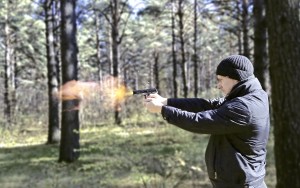
By Daniel Stratton
On July 10, 2015, the Fourth Circuit affirmed the conviction of former Virginia Governor Robert McDonnell on eleven corruption charges stemming from bribes he and his wife, Maureen McDonnell, had accepted from Jonnie Williams, CEO of Star Scientific Inc. The Fourth Circuit provided an explanation for affirming the conviction in a published opinion in the criminal case U.S. v. McDonnell. The appellant, Gov. McDonnell, alleged several errors in the district court. Primarily, Gov. McDonnell challenged the district court’s jury instructions and the sufficiency of the evidence presented at trial. He also argued that the district court erred by refusing to sever his trial from his wife’s, by violating his Sixth Amendment rights in the voir dire process, and by making several erroneous evidentiary rulings. The Fourth Circuit, after reviewing each of Gov. McDonnell’s claims, affirmed his conviction.
Gov. McDonnell and Jonnie Williams Begin a Mutual Quid Pro Quo Relationship
Prior to his election as governor of Virginia in November 2009, Gov. McDonnell had suffered financial setbacks as a result of the economic downtown. Gov. McDonnell and his sister owned and operated Mobo Real Estate Partners LLC, a business that was losing money on a pair of beachfront rental properties. At the time of the 2009 election, Mobo was losing more than $40,000 each year. The Governor and his wife were also accumulating large amounts of credit card debt, which had reached more than $74,000 at the time of his inauguration in January 2010.
Mr. Williams was the founder and CEO of Star Scientific. At the time of Gov. McDonnell’s election, the company was preparing to launch a new dietary supplement called Anatabloc. Star Scientific was in the process of getting Anatabloc classified as a pharmaceutical by the U.S. Food and Drug Administration. To receive a pharmaceutical classification Anatabloc would need to undergo extensive testing and studies, which required funding beyond what Star Scientific means. As a result, the company was looking for outside research and funding.
Gov. McDonnell first met Mr. Williams in December 2009. Mr. Williams had allowed Gov. McDonnell to use his plane throughout his campaign for governor, but the two did not officially met until December, when the Governor-elect had dinner with Mr. Williams to thank him for his support.
In October 2010, the two met again on Mr. Williams’ personal plane during a trip from California back to Virginia. On this flight, Mr. Williams “extolled the virtues of Anatabloc” to Gov. McDonnell and explained that he needed the Governor to help Star Scientific find a place for testing of the product in Virginia. The Governor agreed to introduce Mr. Williams to Virginia’s secretary of health and human resources.
In April 2011, Mr. Williams took Mrs. McDonnell on a shopping spree, which totaled approximately $20,000, while she and the Governor were attending a political rally in New York. Over the next month, Gov. McDonnell and his wife met and communicated with Mr. Williams about Anatabloc. During this time, the Governor reached out to his sister for information on Mobo’s finances and to his daughter to find out how much money the family still owed for her forthcoming wedding.
On May 2, 2011, Mrs. McDonnell met with Mr. Williams and explained her family’s financial troubles. At this meeting, Mrs. McDonnell told Mr. Williams that she had the Governor’s blessing, and that she could help Mr. Williams with securing research for Anatabloc, provided that he helped her with the family’s financial situation. At this meeting, Mr. Williams agreed to loan the McDonnells $50,000 and to provide the remaining $15,000 for their daughter’s wedding. After the meeting, Mr. Williams called Gov. McDonnell to say that he was willing to help with their financial problems and to confirm that the Governor was on board with the plan. Gov. McDonnell replied “Thank you.”
Over the next year, Mr. Williams provided the McDonnell family with expensive vacations, gifts, and additional loans. Mrs. McDonnell twice bought stock in Star Scientific, and unloaded the stocks before they would have to reported on a required financial disclosure form, known as a Statement of Economic Interest.
Throughout this time, Gov. McDonnell and his wife held the Anatabloc launch at the Governor’s Mansion, contacted the state secretary of health and human services about conducting Anatabloc studies at the Medical College of Virginia and the University of Virginia School of Medicine, reached out to the schools when Mr. Williams believed the studies were proceeding too slowly through the school administration, and attempted to persuade the state’s secretary of administration to include Anatabloc in the state employee health plans.
On January 21, 2014, the McDonnells were indicted by a federal grand jury sitting in the Eastern District of Virginia on a fourteen-count indictment. On September 4, 2014, a jury convicted Gov. McDonnell on eleven counts of corruption. Gov. McDonnell was sentenced to two years in prison, followed by two years of supervised release. Gov. McDonnell appealed to the Fourth Circuit, citing a multitude of alleged errors.
The Fourth Circuit Quickly Dispenses with Severance, Voir Dire, and Evidentiary Arguments
While Gov. McDonnell offered a long list of alleged errors at the district court level, the Fourth Circuit quickly disposed of several of the Governor’s allegations before turning to his more substantive challenges. Gov. McDonnell first challenged the district court’s refusal to sever his trial from his wife’s trial. Generally, if multiple defendants are indicted together, courts have held that they should be tried together. In order to have a motion for severance granted, a defendant must show that he has a bona fide need for a co-defendant’s testimony and that co-defendant would waive Fifth Amendment privilege and testify. He must also demonstrate to the court the substance of the testimony and how that testimony would exculpate him.
The Fourth Circuit found this argument to be unpersuasive because Gov. McDonnell offered “only vague and conclusory statements regarding the substance of Mrs. McDonnell’s testimony.” While Gov. McDonnell did offer to share a more detailed description of Mrs. McDonnell’s testimony, it was conditioned on the review of the evidence being ex parte. The lower court found this would violate the concept of due process, because such a review would have prevented the Government from challenging the evidence. The Fourth Circuit found the trial court did not err in that conclusion.
Gov. McDonnell also argued that the district court violated his Sixth Amendment right to an impartial jury because the court polled the potential jurors as a group instead of questioning them individually on whether they could put aside any information they had heard about the case prior to trial. Jury selection remains largely at the discretion of the trial judge and courts generally cannot apply a hard and fast rule for voir dire.
Here, the Fourth Circuit determined that the trial court had correctly proceeded with voir dire. The jury questionnaire used by the court was largely based off of one the parties had jointly submitted. Gov. McDonnell argued that the question asked of the jurors—if they had “expressed” an opinion, instead of formed an opinion—was problematic. However the Fourth Circuit also found that McDonnell bore most of the responsibility for that question, as the version originally proposed by his attorneys invited the potential jurors “to deliberate on [McDonnell’s] guilt or innocence before the case had even started. Additionally, the Fourth Circuit noted that there had been no contention that any actual juror bias had occurred.
As for Gov. McDonnell’s arguments that the district court made multiple erroneous evidentiary errors, the Fourth Circuit found that none of those findings were clearly erroneous. Evidentiary rulings are reviewed for an abuse of discretion, and the circuit court gives significant deference to the district court’s decisions. A district court abuses its discretion “if its conclusion is guided by erroneous legal principles or rests upon a clearly erroneous factual finding.” Because none of the evidentiary issues raised by Gov. McDonnell demonstrated an erroneous decision by the trial court, the Fourth Circuit concluded that none of the district court’s evidentiary rulings should be overturned.
Jury Instructions and Sufficiency of Evidence in the Fourth Circuit
Gov. McDonnell’s most substantive arguments on appeal concerned the jury instructions given by the trial court and the sufficiency of the evidence used to support his conviction. Gov. McDonnell argued that the jury instructions defined bribery far too expansively. When reviewing jury instructions, the appellate court looks at the instructions as a whole and decides whether the instructions accurately state the controlling law. Even if the instructions do not correctly state the law, a circuit court can still find the error to be harmless.
The relevant definition of bribery is “corruptly demanding, seeking, or receiving anything of value in return for being influenced in the performance of any official act.” In the context of bribery, an official act is defined as “any decision or action on any [matter] . . . which may at any time be pending . . . before any public official.” The Fourth Circuit has found that the term “official act” however, does not encompass every action taken by a public official in an official capacity.
An “official act” is not required to be an act explicitly conferred upon an official by a statute. In U.S. v. Birdsall, the Supreme Court explained that an action may be classified as “official” even if it is not explicitly prescribed by statute or a written rule so long as it is found in the “established common usage” of the position. While an official act may be an action that a public official customarily performs, this does not mean that every act an official performs “as a matter of custom” is an official act. Job functions of a public official which are completely ceremonial or educational will usually not fall within the definition of an “official act” in the context of the bribery statute.
Gov. McDonnell also argued that the Government’s evidence was insufficient to support his conviction. On appeal, the Fourth Circuit reviews evidence in the light most favorable to the Government, and if there is substantial evidence supporting a jury conviction, it will be affirmed. In order to prove a quid pro quo arrangement, the government must provide evidence that shows a “specific intent to exchange money (or gifts) for specific official action.”
The Fourth Circuit Finds Jury Instructions were Appropriate and that There was Sufficient Evidence to Convict the Governor
The Fourth Circuit found Gov. McDonnell’s arguments unpersuasive. Gov. McDonnell argued that the jury instructions were too broad because of how they defined an official act. The Governor argued that under this definition, almost anything done by a public official could be construed as an official act, including routine functions such as attending a luncheon or organizing a meeting. Gov. McDonnell claimed that such activities can never constitute an official act and thus the district court incorrectly defined that term in its jury instructions.
The Fourth Circuit did not buy this argument, because the meaning of “official act” as used in the definition of bribery is connected to decisions or actions on matters that may come before the government, not simply any customary act. The court pointed out that the bribery statute criminalizes “corruptly demanding, seeking, or receiving anything of value in return for being influenced in the performance of any official act.” By this definition, the crime is completed when the bribe is either solicited or accepted, regardless of whether or not the “official act” is ever completed (or even started). Further, the court observed, the official act can be an act outside of the bribe recipient’s control, thus it does not matter if the bribe recipient has actual authority over the end result being sought. In his role as Governor, McDonnell had power to influence other public officials and obtain the results Mr. Williams was seeking.
The Fourth Circuit also found that the trial court did not err by denying Gov. McDonnell’s proposed jury instructions, which stated that “merely arranging a meeting, attending an event, hosting a reception, or making a speech” could never constitute an official act. The court found that such a broad statement was unsupported by case law and precedent.
Turning to the strength of the Government’s evidence, the Fourth Circuit dismissed Gov. McDonnell’s claims of insufficiency. The Government presented evidence on three specific matters within the Governor’s sphere of influence: (1) whether researchers at Virginia’s universities would initiate a study on Anatabloc; (2) whether the state Tobacco Commission would provide grant money for studying the active ingredients in Anatabloc; and (3) whether the state health insurance plan would include Anatabloc as a covered drug. The Government did not need to show that Gov. McDonnell actually took official action, but only that there was a corrupt agreement with an expectation that some type of official action would be taken. The Fourth Circuit found that the Government exceeded its burden by showing that the Governor actually used his power to influence government decisions.
The Government also succeeded in showing a quid pro quo relationship by demonstrating a close temporal relationship between Mr. Williams’ gifts and Gov. McDonnell’s actions supporting Anatabloc. The Fourth Circuit noted that Williams’ gifts were not gifts from one friend to another by pointing out that Mr. Williams and Gov. McDonnell did not even know each other until after Gov. McDonnell had been elected. The court concluded that the evidence was such that a jury could readily infer that there were multiple quid pro quo payments and that Gov. McDonnell was acting with corrupt intent.
Fourth Circuit Affirms Gov. McDonnell’s Conviction
The Fourth Circuit affirmed Gov. McDonnell’s conviction on appeal because a review of the record demonstrated that the Governor received a fair trial and was duly convicted by a jury.












